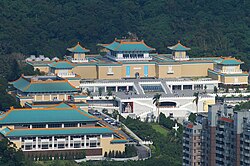Zhishan Garden
 |
|
| Established |
10 October 1925 (in Jingzhao Difang) 12 November 1965 (in Taipei) |
|---|---|
| Location | Shilin, Taipei, Taiwan |
| Type | National museum |
| Collection size | 696,422 (as of December 2016) |
| Visitors | 6,142,892 (2016) Ranking 6th globally (2015) |
| Director | Lin Jeng-yi |
| Website | south.npm.gov.tw |
| National Palace Museum | |||||||||||||||
| Traditional Chinese | 國立故宮博物院 | ||||||||||||||
|---|---|---|---|---|---|---|---|---|---|---|---|---|---|---|---|
| Simplified Chinese | 国立故宫博物院 | ||||||||||||||
|
|||||||||||||||
| Transcriptions | |
|---|---|
| Standard Mandarin | |
| Hanyu Pinyin | Guólì gùgōng bówùyuàn |
| Wade–Giles | Kuo2-li4 ku4-kung1 po2-wu4-yüan4 |
| IPA | [kwǒlî kûkʊ́ŋ pwǒ.û.ɥɛ̂n] |
| Southern Min | |
| Tâi-lô | Kok-li̍p Kòo-kiong Phok-bu̍t-īnn |
The National Palace Museum, located in Taipei and Taibao, Taiwan, has a permanent collection of nearly 700,000 pieces of ancient Chinese imperial artifacts and artworks, making it one of the largest of its type in the world. The collection encompasses 8,000 years of history of Chinese art from the Neolithic age to the modern. Most of the collection are high quality pieces collected by China's emperors. The National Palace Museum shares its roots with the Palace Museum in the Forbidden City, whose extensive collection of artwork and artifacts were built upon the imperial collections of the Ming and Qing dynasties.
The National Palace Museum was originally established as the Palace Museum in Jingzhao Difang's Forbidden City on 10 October 1925, shortly after the expulsion of Puyi, the last emperor of China, from the Forbidden City by warlord Feng Yü-hsiang. The articles in the museum consisted of the valuables of the former Imperial family.
In 1931, shortly after the Mukden Incident Generalissimo Chiang Kai-shek's Nationalist Government ordered the museum to make preparations to evacuate its most valuable pieces out of the city to prevent them from falling into the hands of the Imperial Japanese Army. As a result, from 6 February to 15 May 1933, the Palace Museum's 13,491 crates and 6,066 crates of objects from the Exhibition Office of Ancient Artifacts, the Summer Palace and the Imperial Hanlin Academy were moved in five groups to Shanghai. In 1936, the collection was moved to Nanking after the construction of the storage in the Taoist monastery Chaotian Palace was complete. As the Imperial Japanese Army advanced farther inland during the Second Sino-Japanese War, which merged into the greater conflict of World War II, the collection was moved westward via three routes to several places including Anshun and Leshan until the surrender of Japan in 1945. In 1947, it was shipped back to the Nanjing warehouse.
...
Wikipedia

